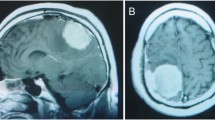Summary
This paper is an attempt at defining the most efficacious surgical and antifungal therapy for invasive cranial and intracranial aspergillosis, and is based on experience with nine non-immuno-compromised patients treated and followed-up by the authors between 1983 and 1994; as well as on the summary of previously reported cases and advances in therapy of this condition. Depending on the degree of aspergillar involvement of the cranial base and intracranial structures, a classification, with implications for treatment and prognosis, is also proposed.
Two patients had extracranial skull base erosion; whereas relentlessly progressive granulomas, mimicking malignancy, invaded the skull base and intracranial contents in seven cases. Of these seven patients with cranial and intracranial invasion, two died of acute intracranial haemorrhage due to fungal invasion of cerebral blood vessels. In two patients, complete surgical eradication of the disease proved impossible due to cavernous sinus involvement, while residual aspergillomas are still present in orbit and paranasal sinuses (PNS) in a further two patients in spite of multiple surgical procedures and prolonged antifungal chemotherapy (AFC). What appears to be a cure has been effected in one patient only. Multiple therapeutic strategies were used. Biopsy plus systemic AFC was ineffective, surgical drainage and debridement plus systemic AFC resulted in long-term survivals but no cure. Radical surgery in conjunction with systemic and local (intracavitary) AFC should be considered to improve an otherwise poor prognosis.
Similar content being viewed by others
References
Batsakis JG, Sciubb JJ (1991) Fungal diseases. In: Blitzer A, Lawson W, Friedman WH (eds) Surgery of the paranasal sinuses. Saunders, Philadelphia, pp 122–123
Blacklock JB, Weber RS, Lee YY, Goepfert H (1989) Transcranial resection of tumors of the paranasal sinuses and nasal cavity. J Neurosurg 71: 10–15
Blitzer A, Post KD, Lawson W (1991) Craniofacial resection. In: Blitzer A, Lawson W, Friedman WH (eds) Surgery of the paranasal sinuses. Saunders, Philadelphia, pp 389–400
Camarata PJ, Dunn DL, Farney AC, Parker RG, Seljeskog EL (1992) Continual intracavitary administration of amphotericin B as an adjunct in the treatment of aspergillus brain abscess: case report and review of the literature. Neurosurgery 31: 575–579
Conti DJ, Rubin RH (1988) Infection of the central nervous system in organ transplant recipients. Neurol Clin 6: 241–260
Friedman WH (1991) Ethmoid sinus. In: Blitzer A, Lawson W, Friedman WH (eds) Surgery of the paranasal sinuses, 2nd Ed. Saunders, Philadelphia, pp 219–228
Goodman ML, Coffey RJ (1989) Stereotactic drainage of aspergillus brain abscess with long-term survival: case report and review. Neurosurgery 24: 96–98
Juneau P, Black PM (1993) Intra-axial cerebral infectious processes. In: Apuzzo MLJ (ed) Brain surgery. Churchill Livingstone, New York, pp 1411–1417
Lawrence RM, Hoeprich PD, Jagdis FA, Monji N, Huston AC, Schaffner CP (1980) Distribution of doubly radio-labelled amphotericin B methyl ester and amphotericin B in the non-human primate. Antimicrob Chemother 6: 241–249
Lawson W, Biller HF (1991) Lateral rhinotomy. In: Blitzer A, Lawson W, Friedman WH (eds) Surgery of the paranasal sinuses. Saunders, Philadelphia, pp 297–308
Lyons RW, Andriole VT (1986) Fungal infections of central nervous system: aspergillosis. In: Booss J, Thornton GF (eds) Neurologic clinics. Saunders, Philadelphia, pp 159–170
Salaki JS, Louria DB, Chmel H (1984) Fungal and yeast infections of the central nervous system. A clinical review. Medicine 63: 108–132
Samii M, Draf W (1989) Surgery of space-occupying lesions of the anterior skull base. In: Samii M, Draf W (eds) Surgery of the skull base. Springer, Berlin Heidelberg New York Tokyo
Stevens DA (1992) Aspergillosis. In: Wyngaarden JB, Smith LH, Bennett JC (eds) Cecil textbook of medicine 19th Ed. Saunders, Philadelphia, pp 1901–1903
Walsh TJ, Hier DB, Caplan LR (1985) Aspergillosis of the central nervous system: clinicopathological analysis of 17 patients. Ann Neurol 18: 574–582
Wilson M, Denning DW (1993) The commonest life-threatening mold infection: invasive aspergillosis. Hospital Update 19: 225–233
Author information
Authors and Affiliations
Rights and permissions
About this article
Cite this article
Naim-Ur-Rahman, Jamjoom, A., Al-Hedaithy, S.S.A. et al. Cranial and intracranial aspergillosis of sino-nasal origin. Acta neurochir 138, 944–950 (1996). https://doi.org/10.1007/BF01411283
Issue Date:
DOI: https://doi.org/10.1007/BF01411283




